
Visual Sense Disambiguation

Polysemy is a problem for methods that exploit image search engines to build object category models. Previously, unsupervised approaches did not take word sense into consideration. We propose a new method that uses a dictionary to learn models of visual word sense from a large collection of unlabeled web data. The use of LDA to discover a latent sense space makes the model robust despite the very limited nature of dictionary definitions. The definitions are used to learn a distribution in the latent space that best represents a sense. The algorithm then uses the text surrounding image links to retrieve images with high probability of a particular dictionary sense.
We also argue that images associated with an abstract word sense should be excluded when training a visual classifier to learn a model of a physical object. While image clustering can group together visually coherent sets of returned images, it can be difficult to distinguish whether an image cluster relates to a desired object or to an abstract sense of the word. We propose a method that exploits the semantic structure of Wordnet to remove abstract senses. Our model does not require any human supervision, and takes as input only the name of an object category. We show results of retrieving concrete-sense images in two multimodal, multi-sense databases, as well as experiment with object classifiers trained on concrete-sense images returned by our method for a set of ten common office objects.
Papers:
K. Saenko and T. Darrell, "Filtering Abstract Senses From Image Search Results"In Proc. NIPS, December 2009, Vancouver, Canada.K. Saenko and T. Darrell, "Unsupervised Learning of Visual Sense Models for Polysemous Words". Proc. NIPS, December 2008, Vancouver, Canada. Yahoo sense dataset.